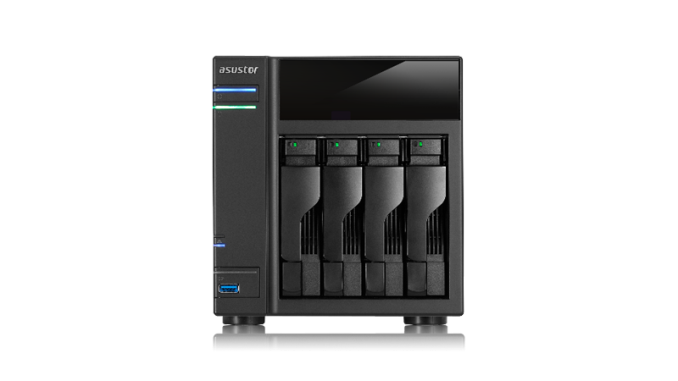Asustor AS-304T: 4-Bay Intel Evansport NAS Review
by Ganesh T S on March 26, 2014 11:15 AM EST
Introduction
NAS units targeting home consumers have traditionally been underpowered in terms of hardware as well as firmware features. Low power, reduced cost and media-centric features are primary requirements in this area. Intel has traditionally been loath to participate in this market segment, probably due to the obvious lack of high margins. However, the explosive growth potential in the consumer / SOHO NAS market has made Intel rethink its strategy.
The Atom CE5300 series was initially introduced as the Berryville set-top-box platform in March 2012. Almost a year later, the CE5300 series was re-launched in its Evansport avatar as a storage solution targeting home consumers (in particular, as a media server platform). Asustor, Synology and Thecus were touted as partners building NAS units based on this platform. We have already looked at the 2-bay Evansport model from Thecus, the N2560. How does the platform perform when scaled up to 4-bays? The Asustor AS-304T gives us a chance to find out.
Asustor places their two Evansport models under the 'Home to Power Users' category. Both of them are based on the Intel CE5335 CPU, and come with 1 GB of RAM. The specifications of the review unit are as below.
| Asustor AS-304T Specifications | |
| Processor | Intel Evansport CE5335 (2C/4T Atom (Bonnell) CPU @ 1.6 GHz) |
| RAM | 1GB DDR3 RAM |
| Drive Bays | 4x 3.5 / 2.5" SATA HDD / SSD (Hot-swappable) |
| Network Links | 1x 1 GbE |
| USB Slots | 2x USB 3.0, 2x USB 2.0 |
| eSATA Slots | None |
| Expansion Slots | None |
| VGA / Display Out | HDMI / 3.5mm Audio Jack |
| Full Specifications Link | Asustor AS-304T Specifications |
| Retail Price | $478 |
In the rest of the review, we will cover the hardware aspects of the AS-304T and provide some setup and usage impressions. This is followed by benchmarks in single and multi-client modes. For single client scenarios, we have both Windows and Linux benchmarks with CIFS and NFS shares. We will also have some performance numbers with encryption enabled. In the final section, power consumption numbers as well as RAID rebuild times will be covered along with some closing notes.
Testbed Setup and Testing Methodology
Our NAS reviews use either SSDs or hard drives depending on the unit under test. While rackmounts and units equipped with 10GbE capabilities use SSDs, the others use hard drives. The Asustor AS-304T was evaluated using four WD Re (WD4000FYYZ) drives to keep comparisons consistent across different NAS units. Evaluation of NAS performance under both single and multiple client scenarios was done using the SMB / SOHO NAS testbed we described earlier.
| AnandTech NAS Testbed Configuration | |
| Motherboard | Asus Z9PE-D8 WS Dual LGA2011 SSI-EEB |
| CPU | 2 x Intel Xeon E5-2630L |
| Coolers | 2 x Dynatron R17 |
| Memory | G.Skill RipjawsZ F3-12800CL10Q2-64GBZL (8x8GB) CAS 10-10-10-30 |
| OS Drive | OCZ Technology Vertex 4 128GB |
| Secondary Drive | OCZ Technology Vertex 4 128GB |
| Tertiary Drive | OCZ RevoDrive Hybrid (1TB HDD + 100GB NAND) |
| Other Drives | 12 x OCZ Technology Vertex 4 64GB (Offline in the Host OS) |
| Network Cards | 6 x Intel ESA I-340 Quad-GbE Port Network Adapter |
| Chassis | SilverStoneTek Raven RV03 |
| PSU | SilverStoneTek Strider Plus Gold Evoluion 850W |
| OS | Windows Server 2008 R2 |
| Network Switch | Netgear ProSafe GSM7352S-200 |
Thank You!
We thank the following companies for helping us out with our NAS testbed:
- Thanks to Intel for the Xeon E5-2630L CPUs and the ESA I-340 quad port network adapters
- Thanks to Asus for the Z9PE-D8 WS dual LGA 2011 workstation motherboard
- Thanks to Dynatron for the R17 coolers
- Thanks to G.Skill for the RipjawsZ 64GB DDR3 DRAM kit
- Thanks to OCZ Technology for the two 128GB Vertex 4 SSDs, twelve 64GB Vertex 4 SSDs and the RevoDrive Hybrid
- Thanks to SilverStone for the Raven RV03 chassis and the 850W Strider Gold Evolution PSU
- Thanks to Netgear for the ProSafe GSM7352S-200 L3 48-port Gigabit Switch with 10 GbE capabilities.
- Thanks to Western Digital for the two WD Re hard drives (WD4000FYYZ) to use in the NAS under test.










34 Comments
View All Comments
CalaverasGrande - Friday, March 28, 2014 - link
For my presonal NAS I simply can't afford to pay for the amount of backup that would entail. Instead I replicate the core of the data between two units at different locations.The stuff that I work with/use on a regular basis is not replicated. If I did it would replicate accidental deletions and changes.
I'm working on getting some of my friends and family on board with this arrangement so that we are replicating each others data. Hence preserving it in case of theft fire or disaster.
freespace303 - Tuesday, April 1, 2014 - link
Have you heard of Backblaze? Unlimited backup for $5 a month. I heard about it on a TwiCH podcast.patu - Thursday, March 27, 2014 - link
What mount options did CentOS use? Distro can change the default mount options.Hrel - Thursday, April 3, 2014 - link
Can someone please explain to me why all NAS enclosures that have more than 2 bays are SO expensive? I mean, for $500 I can build a full power desktop and just install FreeNAS on it. At the same time I can buy a 2-bay NAS spec'd like this one for around $100. Then make the case twice as large and the price jumps up $400?!?! I am thoroughly confused by this phenomena.Shouldn't a 4 bay enclosure be, at most, $200?